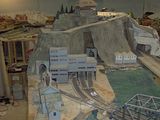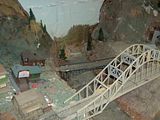Hi. I’m new to the forum. I’ve recently tried my hand at modeling a pond and lake. I’ve been using W.S. Realistic Water. I pour a thin coat of the product and after about 12 hours, the product begins to crack. Any tips on what I may be doing wrong? Thanks!
I’ve used the product a couple of times but, thankfully… didn’t have this problem. Was the bottom perfectly smooth? Was the amount you poured an 1/8th inch or less? I know this question is way out there but what was the overnight temperature in the room?
Jarrell
Welcome.
I’m afraid part of the hobby is something not going just as planned. I think we’ve all been there and done that in one area or another.
Have not used WS RW, but do have a small pond done with Envirotex.
In addition to the above questions, what is the base of your pond made of? Was it completely dry when you poured your water? I used plaster and let it dry for several days, then painted it, waited a few days then started pouring water. Pours were usually a couple of days apart, so they had dried. If you are using Sculptamold for your base, I would recommend letting it set even longer to dry before painting, as I found it somewhat slower to dry when I used it other places.
As usual, I suggest making a tent out of a paper bag or newspaper, over your pour, so that dust and other unwanted materials to not find the surface of your pond.
Good luck,
Richard
Thanks for the reply. The bottom wasn’t smooth because I had painted different colors on it using acrylic paint. I only poured about 1/8 inch and the room temp is always at 67.
Thanks Richard. The room temp is always 67 degrees. The bottom was painted with acrylic paint and was a bit rough. I only poured 1/8 of an inch deep. The base is plywood. I wonder if I’d be able to peel the stuff up?
If you haven’t done it yet, give the folks at Woodland Scenics a call. They are extremely knowledgeable and quite willing to help you. I am in the final stages of a harbor extension to my layout, and plan to use Realistic Water to model my 1’ by 4’ harbor. I called WS several times and spoke with Kathy (don’t know if it’s Kathy with a K or a C), and she saved me from making several simple but serious mistakes. Realistic Water, being acrylic, can react negatively with some other mediums. There is no such thing as a stupid question, especially when it can save you a do over. Check out the FAQ’s as well at woodlandscenics.com.
Will.
Did you just paint the plywood, then pour the WS Realistic Water, or did you make a shallow basin of plaster or Sculptamold to form the bottom? Any time I have seen discussions on pouring water, some sort of basin was formed to pour the material into. If you went directly onto the painted plywood, that may make a difference. Just a guess.
If you had a basin of plaster or Sculptamold, you could get it off, not sure if you are right on the plywood.
Good luck,
Richard
Although not a great fan of the Realistic water, I haven’t had any problem w/ it cracking. What I don’t like is that it is much too soft a product (rubbery or plastic like) tends to not really level @ or around edges and rocks, stumps etc. Even after it is cured, anything placed on the surface will start to dent or sink. I would recommend using Enviortex Lite for the pour. The Ws Acrylic does has uses for doing quick mud puddles, drainage ditches etc. but for larger water features, just not happy w/ it at all.
Try a second pour to just fill the cracks. If they are still obvious I venture to say that you may have to remove it. If it is to be a muddy or swampy pond, adding debris to hide and using the Envirotex might hide the mess below. Tinting the first thin layer if applicable would also help.
I would second the idea of making another pour of the realistic water. I have used it several times with no cracking and have poured several layers to get the look I wanted. I have just made a sixth pour on a T-Trak module to get the depth I want. The first and second pour was with some realistiuc water that was opened about 10 years ago. It was poured over rough, painted Hydrocal.
Thanks. I don’t currently have any Sculptamold. Would Smooth It work as well? Either way, could I still use acrylic oil paint on top or do I need to use a liquid paint? Joe
I would think any plaster like product should work for the base of your pond.
You used the term “acrylic oil paint”. Acrylic and oil paints are two different things. Acrylic is a water based paint, oil paints are oil based. Acrylic paint in a tube looks much like oil paint in a tube. As far as I know water based acrylic or craft paint should work alright. I am not sure about the oil paints, they might react with the WS product causing your problem. Check your products and see which you are using. When talking about oil paints, I am not referring to the solvent based hobby paints, but artist oil paints that come in a tube,
Another thing, if you happen to be using oil paints they take much longer to dry than
Good luck,
Richard
Sorry for the confusion. It is an acrylic water based paint. Another person suggested using Envirotex Lite so I ordered some and will give it a try.
There is an oil paint that has water clean-up now and can have small amounts of water added to them!
You can tint the Envirotex w/ drops of acylic/ even craft paint if you feel the water will be too clear. mrB and others have also had success in doing so. Tinting the first layers will also give the added depth of the water once you pour the final clear on top. I have even placed small debris/ fine grasses etc. between layers for swampy or a pond scum look. Cat tails, tall grasses can even be placed before the final coat thickens. Just not sure what water feature you are doing.
Welcome to the Trains.com Forum, For a large harbor, I used office door window plastic with a tiny random pattern on one surface. I painted the smooth surface with a fairly uniform dark blue-green. Personally, I prefer either Envirotex or Magic Water, to WS Realistic Water. I also suggest using Hydrocal plaster. It is water-proof and forms a hard smooth surface. I use Hydrocal for my cascading rivers. 
 Click on photos to enlarge them. Then, click on “Previous” or “Next” arrows to see other views of my 24’x24’ around the room layout. Bob Hahn
Click on photos to enlarge them. Then, click on “Previous” or “Next” arrows to see other views of my 24’x24’ around the room layout. Bob Hahn
I have used Realistic water on several applications and never had it crack.
I always use a plaster cloth base, then apply Hydrocal to seal the base. It does not need to be smooth. I then paint the Hydrocal, after it dries, with a latex paint.
The one problem that I have had with Realistic Water is with multiple pours. Even if the pour is no deeper than 1/8 inch, it tends to cloud up badly and then takes weeks to clear. Woodland Scenics recommends no more than two 1/8 inch pours.
If your pour has cracked, it could be because it was applied directly onto plywood, or it is too old, or you made too many pours.
You could scrape it up with a putty knife and start all over, and if it is cracking, that may be the best thing to do,
Rich
Thanks to everyone for the ideas. I removed the old stuff and started over. Started with a layer of plaster cloth. Got it smooth. Then a coat of latex.
Does anyone have any suggestions on how to put the paints down without have harsh transition lines between colors?
Will finish up with Envirotex Lite as many of you suggested. Joe
Dry brushing. Lightly feather the colors into each other.
Never considered that Jeff. Can you take me through each step? Do you start with a black bottom? Use any blue or green?
Great pix and god ideas. Thanks.